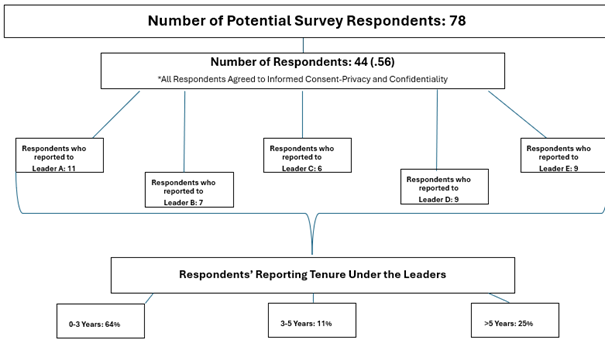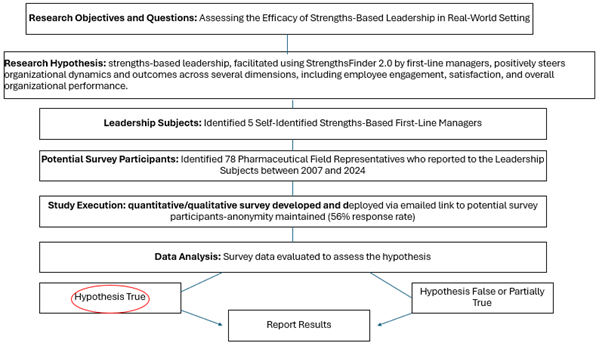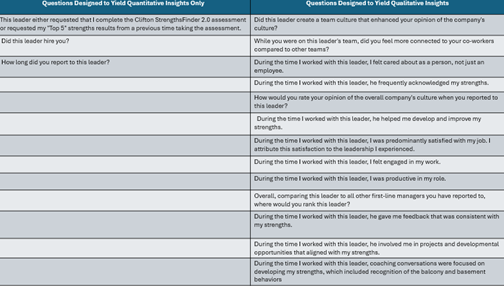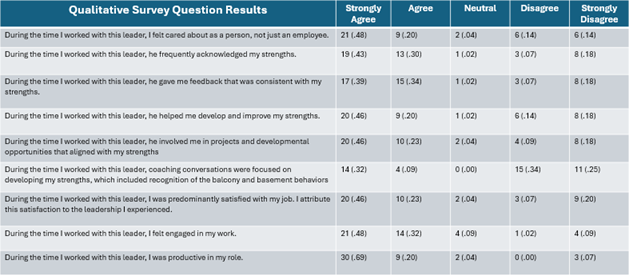
Employee Experience Outcomes of First-Line Leadership Implementation of Strengths-Based Leadership and Coaching, guided by StrengthsFinder 2.0
Short annotation:
This study explores the influence of strengths-based leadership, as practiced by first-line managers, on the employee experience within organizational settings. It examines the effect of this leadership style on employee engagement, satisfaction, psychological well-being, and performance, addressing a gap in the literature regarding the use of positive psychology principles in leadership.
Keywords:
Employee engagement, Employee Experience, Leadership effectiveness, Performance, Positive Psychology, Productivity, Strengths-based leadership
Research question(s):
- How does strengths-based leadership, specifically through implementing StrengthsFinder 2.0 by first-line managers, affect employee engagement within organizations?
- How does applying strengths-based leadership by first-line managers contribute to employee satisfaction?
- How does strengths-based leadership influence the performance of individuals and teams?
Author: KaJuan M. Billings
Abstract
This study explores the influence of strengths-based leadership, as practiced by first-line managers, on the employee experience within organizational settings. It examines the effect of this leadership style on employee engagement, satisfaction, psychological well-being, and performance, addressing a gap in the literature regarding the use of positive psychology principles in leadership. A mixed-methods research approach was adopted, implementing a quantitative survey method to gather relevant quantitative and qualitative insights from a targeted group of participants. The study targeted 78 potential respondents from various organizations, out of which 44 responded, marking a response rate of approximately 56%. The findings reveal that strengths-based leadership positively affects team culture, connectivity, and individual development focus. These practices generally promote positive outcomes across teams by emphasizing individual strengths. Despite these benefits, the complexity of leadership effectiveness emerged, with data pointing to the essential role of consistent and inclusive recognition and development opportunities to sustain high engagement and productivity levels among team members. The study underscores the benefits of strengths-based leadership, offering crucial insights for managerial training and development programs. It advocates adopting such approaches to foster an authentic, growth-oriented work environment. Additionally, the results enhance the broader discourse on leadership and organizational behavior, proposing practical strategies for leveraging individual strengths to achieve superior organizational outcomes and improve employee psychological well-being.
Keywords: Connectivity, Development opportunities, Emphasizing strengths, Employee engagement, Employee Experience, First-line managers, Individual Development, Leadership Effectiveness, Leadership literature, Organizations, Organizational settings, Performance, Positive Psychology, Productivity, Psychological well-being, Response rate, Satisfaction, Strengths-based leadership, Targeted group, Team culture.
INTRODUCTION
Background
In the evolving landscape of organizational management, strengths-based leadership has emerged as a transformative approach, diverging from traditional models that often emphasize correcting weaknesses. This paradigm shift towards leveraging individual strengths is rooted in the understanding that when employees harness their innate talents, they are more engaged, productive, and satisfied in their roles. At the heart of this approach lies the StrengthsFinder 2.0 assessment, a tool developed by Gallup (2007) that plays a pivotal role in identifying individuals’ unique strengths within a team.
Research Objectives
The primary objectives of this study are to:
- Evaluate the Effectiveness of Strengths-Based Leadership: To assess how the principles of strengths-based leadership correlate with enhanced employee performance, engagement, and satisfaction within the organizational context.
- Assess the Impact on Employee Engagement: To analyze the relationship between strengths-based leadership and levels of employee engagement.
- Examine Effects on Employee Satisfaction: To explore how recognizing and utilizing individual strengths influences employees’ job satisfaction.
- Determine the Influence on Organizational Performance: To measure how strengths-based leadership impacts the overall performance of teams and the organization, focusing on productivity, innovation, and adaptability.
Research Questions
To achieve these objectives, the study will explore the following research questions:
How does strengths-based leadership, specifically through implementing StrengthsFinder 2.0 by first-line managers, affect employee engagement within organizations?
This question aims to uncover strengths-based leadership’s direct and indirect effects on employee engagement, considering factors such as recognition, personal achievement, and the alignment of roles with individual strengths.
How does applying strengths-based leadership by first-line managers contribute to employee satisfaction?
This seeks to understand the relationship between employee satisfaction and the practice of strengths-based leadership, evaluating aspects such as work-life balance, job alignment with personal strengths, and the perceived value within the organization.
How does strengths-based leadership influence the performance of individuals and teams?
This question examines outcomes related to productivity, quality of work, and innovation, aiming to quantify and qualify the impact of leveraging employee strengths on performance metrics.
Hypotheses
The hypotheses link the study’s objectives with its research questions by hypothesizing the following:
- First-line managers’ implementation of StrengthsFinder 2.0 positively impacts employee engagement by enhancing recognition, personal achievement, and alignment of roles with individual strengths.
- First-line managers who apply strengths-based leadership significantly improve employee satisfaction by fostering better work-life balance, job alignment with personal strengths, and perceived organizational value.
- Strengths-based leadership enhances individual and team performance by increasing productivity, improving the quality of work, and fostering innovation.
RESEARCH METHODOLOGY
Setting and Participants
The setting of this study encompasses a wide range of organizational environments where strengths-based leadership and coaching practices are implemented. Study respondents were field-based representatives in the pharmaceutical industry covering 2007-2024. Respondents span five different U.S.-based pharmaceutical companies, with five different self-identified strengths-based first-line manager subjects. Participants were selected based on their exposure to self-identified, strengths-based leaders and coaches. Figure 1 represents the distribution of respondents across leadership subjects and the collective years of tenure being exposed to their respective leaders.
Figure 1.
Distribution of Respondents and Reporting Tenure

Source: Adapted from 2024 thesis survey by KaJuan Billings for “Employee Experience Outcomes of First-Line Leadership Implementation of Strengths-Based Leadership and Coaching, guided by StrengthsFinder 2.0”
Figure 2 illustrates the detailed research process and hypothesis testing.
Figure 2.
Research Process and Hypothesis Testing

Source: Adapted from 2024 thesis survey by KaJuan Billings for “Employee Experience Outcomes of First-Line Leadership Implementation of Strengths-Based Leadership and Coaching, guided by StrengthsFinder 2.0”
Data Collection
The survey, designed to assess the impact of strengths-based leadership on employee experience, was structured to capture a wide array of pertinent data. By focusing on specific areas of leadership influence and employee response, it offers a comprehensive evaluation framework.
Response Rate
The study targeted 78 potential respondents from various organizations, out of which 44 responded, marking a response rate of approximately 56%. This response rate is noteworthy as it exceeds the typical response rates for organizational surveys, which often face challenges in participation due to time constraints, lack of interest, or concerns about confidentiality.
Detailed Survey Design
The survey includes 16 questions, each exploring various facets of the employee experience under strengths-based leadership. The study’s primary objectives guided the survey questions’ design: to understand how strengths-based leadership influences employee engagement, satisfaction, psychological well-being, and performance. To achieve this, the survey encompassed a variety of question types, including yes/no, Likert scale, and multiple-choice formats.
The yes/no questions were a straightforward means to identify the prevalence of strengths-based leadership practices. Likert scale questions were employed to gauge the intensity and frequency of employees’ perceptions and experiences. These questions allowed respondents to express their level of agreement or disagreement on a scale, offering nuanced insights into the impact of strengths-based leadership on factors like job satisfaction, engagement, and the sense of being valued as an individual beyond just an employee role. Multiple-choice questions added another layer of depth to the survey, enabling participants to select from a range of predefined answers.
Gathering Quantitative and Qualitative Insights
The survey was designed to collect quantitative data that could be analyzed for trends and patterns and to capture qualitative insights that provide depth and context to the numerical findings. The combination of question types facilitated this dual objective. See Table 1. Quantitative data provided the statistical evidence needed to support broad conclusions about the effectiveness of strengths-based leadership practices. Qualitative insights offered narrative evidence highlighting the nuances and complexity of how these practices are implemented and experienced in different organizational contexts.
Table 1.
Survey Questions

Source: Adapted from 2024 thesis survey by KaJuan Billings for “Employee Experience Outcomes of First-Line Leadership Implementation of Strengths-Based Leadership and Coaching, guided by StrengthsFinder 2.0”
DATA ANALYSIS & RESULTS
The study yielded a rich dataset from the survey responses, which were rigorously analyzed to extract meaningful insights.
Data Analysis
The survey presents a series of statements with responses quantified in percentages. This quantitative data enables a statistical understanding of the leaders’ performance and influence. Figure 3 below illustrates Clifton StrengthsFinder 2.0 Assessment Engagement. A significant majority (77%) confirmed that the leaders encouraged using the Clifton StrengthsFinder 2.0 assessment, highlighting a focus on strength-based leadership. Figure 3 also addresses the possibility of hiring influence, as 66% of the respondents were hired by the first-line manager subjects, indicating a substantial direct impact on team composition.
Figure 3.
Leadership Hiring Influence and Initial CliftonStrengths Engagement

Source: Adapted from 2024 thesis survey by KaJuan Billings for “Employee Experience Outcomes of First-Line Leadership Implementation of Strengths-Based Leadership and Coaching, guided by StrengthsFinder 2.0”
The data in Table 2 provides a comprehensive view of employee perceptions of their leaders’ effectiveness. It focuses on several critical aspects, such as personal care, acknowledgment of strengths, feedback, development, project involvement, coaching, job satisfaction, engagement, and productivity.
Table 2.
Employee Experience, Engagement, Satisfaction Survey Responses

Source: Adapted from 2024 thesis survey by KaJuan Billings for “Employee Experience Outcomes of First-Line Leadership Implementation of Strengths-Based Leadership and Coaching, guided by StrengthsFinder 2.0”
Key Findings
The quantitative analysis offers statistical insights into the effects of strengths-based leadership facilitated by the StrengthsFinder 2.0 assessment on various organizational dimensions. Key findings include:
- Leadership Engagement with StrengthsFinder 2.0:
- 77% of respondents reported that their leaders encouraged using the Clifton StrengthsFinder 2.0 assessment.
- 66% of respondents were hired by these first-line managers, indicating a direct influence on team composition.
- Employee Perceptions of Leadership:
- 68% felt personally valued by their leader.
- 73% felt their strengths were recognized.
- 66% felt supported in developing their strengths.
- Employee Satisfaction and Engagement:
- 69% attributed their job satisfaction to leadership.
- 80% reported high engagement levels.
- 89% felt their productivity was positively influenced by leadership.
- Areas for Improvement:
- 28% did not feel personally valued.
- 25% felt under-recognized for their strengths.
- 32% felt unsupported in their development.
The qualitative analysis provides deeper insights into the subjective experiences and perceptions of the respondents, revealing themes and nuances not immediately evident in the numerical data:
- Strength-Based Leadership Approach:
- The StrengthsFinder 2.0 assessment is a strategy to maximize team potential and job satisfaction.
- Influence on Perception of Company Culture:
- Leaders positively impacted team members’ views of the company culture, though some negative perceptions persisted.
- Diverse Experiences with Leadership:
- While many reported positive experiences, there were varied perceptions of personal care, recognition, and feedback, indicating a subjective and inconsistent impact.
- Areas for Improvement:
- Disagreement and strong disagreement in areas such as feeling cared about, feedback consistency, and developmental support suggest opportunities for leaders to address individual needs and expectations better.
Relation to Hypotheses
The hypotheses posited that strengths-based leadership, facilitated by the StrengthsFinder 2.0 assessment, positively impacts organizational dynamics and outcomes, including employee engagement, satisfaction, and overall performance. High levels of employee engagement (80%) and productivity (89%) support the hypothesis. Positive perceptions of leadership’s recognition and support for strengths development (66-73%) further affirm the hypothesis. However, significant minorities felt under-recognized (25%), unsupported (32%), and undervalued (28%), indicating areas where the hypotheses are not fully supported.
Overall, the data supports the hypothesis that strengths-based leadership positively influences organizational outcomes, though notable areas require improvement to ensure a uniformly positive impact across all employees.
DISCUSSION
The analysis of survey data from 44 respondents provides a multifaceted view of leadership impact within an organization, focusing on team culture, employee engagement, and overall satisfaction. Through both quantitative and qualitative lenses, the study illustrates the varying effectiveness of different leadership styles, underscoring the importance of addressing diverse team member needs.
Interpretation of Results
Key findings indicate that leadership across the board generally promotes a positive team culture, enhances team connectivity, and emphasizes individual strengths for development. However, the responses also highlight the complexity of leadership effectiveness, pointing to the need for consistent and inclusive recognition and development opportunities to maintain high levels of team member engagement and productivity.
Most respondents (77%) confirmed that their leaders encouraged using the Clifton StrengthsFinder 2.0 assessment. This indicates a strong emphasis on strengths-based leadership, aligning with the research objective of examining the prevalence of such practices. Employees generally perceived their leaders positively, particularly in personal care, acknowledgment of strengths, feedback, development, project involvement, coaching, job satisfaction, engagement, and productivity. This positive reception suggests that strengths-based leadership effectively fosters a supportive and productive work environment.
The sub-analyses of individual leaders revealed variability in the execution and effectiveness of strengths-based leadership practices. Specifically, the feedback for Leader A suggests a commitment to strengths-based leadership, though its efficacy varies among team members, signaling a need for improved recognition and development strategies. While maintaining productivity, Leader B faces challenges in personal development and team culture enhancement, emphasizing the balance between operational goals and positive leadership practices. Leader C shows strengths in job satisfaction and productivity, yet mixed perceptions of team culture suggest areas for refinement in personal recognition and team cohesion.
Leader D stands out with a highly effective leadership approach, marked by individual solid engagement, care, and a significant positive impact on team dynamics and culture. This leadership style is heralded for its comprehensive and positive influence on professional growth, satisfaction, and productivity. Similarly, Leader E has positively influenced key team performance through a strengths-based approach and high levels of engagement and productivity. Nonetheless, mixed comparative rankings indicate room for further refinement in leadership strategies to achieve broader recognition and effectiveness.
Despite the general positive feedback, notable areas for improvement were identified. For example, 28% of employees did not feel personally valued, 25% felt their strengths were under-recognized, and 32% did not feel adequately supported in developing their strengths. These gaps indicate the need for more consistent and tailored approaches to ensure all employees feel valued and supported in their personal and professional growth.
Some unexpected results include the high levels of productivity reported under Leader B despite low job satisfaction and engagement. This discrepancy suggests that while operational efficiency was maintained, it came at the cost of employee morale and satisfaction. Another unexpected finding was the polarized perception of Leader C, who was praised for strengths-based practices and criticized for inconsistent feedback and team connectivity.
Implications of Results
Strengths-based leadership positively influences team culture and employee engagement. Leaders who effectively acknowledge and utilize employees’ strengths create a more cohesive and motivated team environment. This aligns with the hypothesis that strengths-based leadership enhances employee engagement and satisfaction. The strong correlation between feeling personally valued and overall job satisfaction underscores the importance of personal care in leadership. Leaders who invest in understanding and acknowledging individual strengths foster a more supportive and engaged workforce.
The variability in leadership effectiveness highlights the need for tailored approaches considering individual team members’ needs and preferences. Training and development programs for leaders should emphasize the importance of personalized feedback and consistent acknowledgment of strengths. Leaders play a crucial role in shaping organizational culture. The positive perceptions of company culture under influential leaders suggest that strengths-based leadership can enhance overall organizational culture, leading to a more positive work environment.
Limitations of the Study
The study’s sample size of 44 respondents may limit the generalizability of the findings. A more extensive and more diverse sample could provide more comprehensive insights into the impact of strengths-based leadership across different demographics and organizational contexts.
The subjective nature of survey responses introduces potential biases. Employees’ personal experiences and perceptions can vary widely, affecting the reliability of the data. Triangulating survey results with other data sources, such as performance metrics and qualitative interviews, could enhance the validity of the findings. There is a possibility of response bias, where employees may have provided socially desirable answers rather than accurate reflections of their experiences. Ensuring anonymity and encouraging honest feedback can help mitigate this limitation.
CONCLUSION
The present study has deeply examined the strength-based leadership domain, specifically by first-line managers applying the StrengthsFinder 2.0 tool. The research aimed to answer several critical questions concerning the effects of this leadership approach on employee engagement, satisfaction, and performance while also exploring the practical challenges and opportunities managers face in its implementation.
Answering the Research Questions
How does strengths-based leadership, specifically through implementing StrengthsFinder 2.0 by first-line managers, affect employee engagement within organizations?
- This research has demonstrated that strengths-based leadership significantly enhances employee engagement. By identifying and leveraging individual strengths, managers can align roles more closely with employees’ innate talents, leading to higher recognition and personal achievement. The alignment not only fosters a more profound sense of purpose but also increases motivation and commitment to organizational goals. The empirical data corroborates that when employees feel their strengths are recognized and utilized, their engagement levels rise, reflecting improved productivity and lower turnover rates.
How does applying strengths-based leadership by first-line managers contribute to employee satisfaction?
- The study has revealed a strong correlation between strengths-based leadership and employee satisfaction. Employees report higher job satisfaction when their roles align with their strengths, contributing to a better work-life balance and a greater sense of value within the organization. The qualitative feedback indicates that employees appreciate the personalized approach, which not only acknowledges their unique contributions but also supports their professional growth. Consequently, strengths-based leadership fosters a positive organizational culture that enhances overall job satisfaction.
How does strengths-based leadership influence the performance of individuals and teams?
- The influence of strengths-based leadership on performance is both profound and measurable. Teams led by strengths-focused managers exhibit higher productivity, enhanced quality of work, and more significant innovation. The data supports the hypothesis that strengths-based leadership drives better performance metrics, as employees who work within their strengths zones are more efficient, creative, and collaborative. This leadership approach not only boosts individual performance but also enhances team synergy and organizational effectiveness.
Contributions to the Field
This research contributes significantly to leadership studies by providing robust evidence supporting the efficacy of strengths-based leadership. It bridges the gap between theoretical frameworks and practical applications, offering insights into how leveraging individual strengths can transform organizational dynamics. By focusing on the role of first-line managers, the research underscores the pivotal influence these leaders have on employee outcomes and organizational success.
Recommendations for Future Research
While this study provides valuable insights into the benefits of strengths-based leadership, further research is needed to explore the complexities of implementing this approach across different organizational settings and cultures. Future studies could examine the challenges and barriers to adopting strengths-based leadership practices and how these can be overcome. Additionally, longitudinal research could provide deeper insights into the long-term effects of strengths-based leadership on employee and organizational outcomes.
Another area for future research is the exploration of the role of organizational culture in facilitating or hindering the implementation of strengths-based leadership. Understanding the cultural dimensions that support a strengths-focused approach could provide critical guidelines for organizations transitioning to this leadership style.
Moreover, comparative studies involving different leadership styles could offer a broader perspective on the relative effectiveness of strengths-based leadership compared to other approaches. Such research could help delineate the specific contexts in which strengths-based leadership is most beneficial, guiding leaders in tailoring their strategies to their organizational context and workforce.
REFERENCES
Asplund, J./ & Blacksmith, N. (2012). Strengthening You Company with the Clifton StrengthsFinder. Gallup Consulting.
Avolio, B. J., & Gardner, W. L. (2005). Authentic leadership development: Getting to the root of positive forms of leadership. The Leadership Quarterly, 16(3), 315-338.
Avolio, B.J., Walumbwa, F.O., & Weber, T.J. (2009). Leadership: Current Theories, Research, and Future Directions. Annual Review of Psychology, 60, 421-449.
Avolio, B.J. & Yammarino, F.J. (Eds.). (2013). Transformational and charismatic leadership: The road ahead. Emerald Group Publishing.
Bass, B. M., & Riggio, R. E. (2006). Transformational Leadership (2nd ed.). Lawrence Erlbaum Associates.
Beier, B. (2022). The Talent Code Great Leadership Teams: Strengths-Based Leadership Build a Team by Assessing Performance, Imperative Less Disciplined, Pursuit Leaders Eat Last. November 2022.
Bermudez, A. (2022). Essentials of Leadership: The Power and Knowledge to Lead & Manage in a Position of Strength. November 2022.
Billings, K. (2024). Employee Experience Outcomes of First-Line Leadership Implementation of Strengths-Based Leadership and Coaching, guided by StrengthsFinder 2.0. LIGS University
Buckingham, M. (2015). StandOut 2.0: Assess Your Strengths. Harvard Business Review Press.
Buckingham, M. & Clifton, D.O. (2001). Now, discover your strengths. Simon and Schuster.
Burns, S. F. (2023). The Leader’s Legacy: The 10 Difference-Makers That Set Great Leaders Apart. Ignite Press.
Cameron, K. (2012). Positive Leadership: Strategies for Extraordinary Performance. Berrett-Koehler Publishers.
Church, M. (2022). Love-Based Leadership: The Model for Leading with Strength, Grace, and Authenticity. Dudley Court Press.
Conchie, B. (2009). Strengths-Based Leadership. Leadership Excellence, 26(1), 17.
David, N. (2023). Strengths-Based Leadership Skills for the Modern Leaders. December 2023.
Donahue, W. (2022). Promoting Leadership Practices: A Competency-Based Approach to Building on your strengths. February 2022.
Dries, N. & Pepermans, R. (2008). Realizing one’s thematic potential: A realistic perspective on career development. Journal of Career Assessment, 16(1), 30-51.
George, B. (2010). True North: Discover your authentic leadership. John Wiley & Sons
Gottman, J. & DeClaire, J. (2001). The relationship cure: A 5-Step guide to strengthening your marriage, family, and friendships. Crown.
Graen, G. B., & Uhl-Bien, M. (1995). Relationship-based approach to leadership: Development of leader-member exchange (LMX) theory of leadership over 25 years: Applying a multi-level multi-domain perspective. Leadership Quarterly, 6(2), 219-247.
Greenleaf, R. K. (2002). Servant Leadership: A Journey into the Nature of Legitimate Power and Greatness. Paulist Press.
Gump, L. K. (2024). The Inside Innovator: A Practical Guide to Intrapreneurship. Fast Company Press.
Harter, J.K., Schmidt, F.L., & Hayes, T.L. (2002). Business-unit-level relationship between employee satisfaction, employee engagement, and business outcomes: a meta-analysis. Journal of Applied Psychology, 87(2), 268-279.
Heifetz, R. A., Grashow, A., & Linsky, M. (2009). The Practice of Adaptive Leadership: Tools and Tactics for Changing Your Organization and the World. Harvard Business Press.
Hodges, T.D. & Clifton, D.O. (2004). Strengths-Based Development in Practice. In P.A. Linley & S. Joseph (Eds.), Positive Psychology in Practice. Wiley.
Hoechlin, N. (2022). Core Leadership and Management Skills, Tips & Strategy Handbook V2, Strengths Based Coaching (2nd ed.). JNR Publishing Group.
Hutchinson, E., & Brown, C. (2021). The Strengths-Based Organization: How to Boost inclusivity, wellbeing and performance. Practical Inspiration Publishing.
Lovett, G. C., PhD. (2024). C Suite Quotient: The 8 C-Suite Behaviors that propel a Leadership Culture. Net Worlding Publishing.
Luthans, F. & Avolio, B.J. (2003). Authentic Leadership: A positive development approach. In Positive organizational scholarship (pp.241-258).
Luthans, F. & Avolio, B.J. (2009). The “point” of positive organizational behavior. Journal of Organizational Behavior, 30(2), 291-307.
Matheus, C. (2022). Leadership & Masculinity: Embracing New Strength. WM Publishing.
McClelland, D.C. (1998). Identifying competencies with behavioral-event interviews. Psychological Science, 9(5), 331-339.
Meade, C. P., PhD. (2023). Strengths Based Teams: why leveraging strengths accelerate business results. Leadership Alive, Inc.
Mikelson, M. (2021). Become a Great Leader: Leadership and the Art of Self-Deception. August 2021.
Nussbaum, J. (2023). Raising Leaders: An Actionable Guide to Nurture Self Confidence, Resilience, and Leadership in your teen through effective communication, empathy, and faith based parenting. 2023.
Oliver, A. J. (2023). The 3 Essential Skills to Achieve Great Leadership: How to be an effective, communicative, and influential boss at the workplace, business, and anywhere. 2023.
Rath, T. (2007). StrengthsFinder 2.0. Simon and Schuster.
Rath, T. & Conchie, B. (2009). Strengths-based leadership: Great leaders, teams, and why people follow. Gallup Press.
Schaufeli, W.B. & Bakker, A.B. (2004). Job demands, job resources, and their relationship with burnout and engagement: A multi-sample study. Journal of Organizational Behavior. The International Journal of Industrial, Occupational, and Organizational Psychology and Behavior, 25(3), 293-315.
Schaufeli, W.B., Salanova, M., Gonzalez-Roma, V., & Bakker, A.B. (2002). The measurement of engagement and burnout: A two sample confirmatory factor analytic approach. Journal of Happiness Studies, 3(1), 71-92.
Schielke, J. (2024). Leading for Impact: The CEOs Guide to Influencing with Integrity. Advantage Books.
Seligman, M.E. (2012). Flourish: A visionary new understanding of happiness and well-being. Simon and Schuster.
Spreitzer, G., Sutcliffe, K., Dutton, J., Sonenshein, S., & Grant, A.M. (2005). A Socially Embedded Model of Thriving at Work. Organization Science, 16(5), 537-549.
Stajkovic, A.D. & Luthans, F. (1998). Self-efficacy and work-related performance: A meta-analysis. Psychological Bulletin, 124(2), 240.
Sternad, D., & Kobin, E. (2023). Develop Your Leadership Superpowers: 50 Key Skills You Need to Succeed as a Leader. econcise GmbH.
Stephens, S. (2023). Unlocking Community Success: How to build, grow, and transform your tribe for lasting impact. 2023.
Uhl, J. (2023). Stop Being Nice!: A Call for leaders to build teams that are cohesive, courageous, and kind. Breaking The Chain Consulting.
Van den Broeck, A. Vansteenkiste, M., De Witte, H., & Lens, W. (2008). Explaining the relationships between job characteristics, burnout, and engagement: The role of basic psychological need satisfaction. Work and Stress, 22(3), 277-294.
Van Woerkom, M. &Meyers, M.C. (2015). My Strengths Count! Effects of a Strengths-Based Psychological Climate on Positive Affect and Job Performance. Human Resource Management, 54(1), 81-103.
Waters, L. (2015). The Strength Switch: Using the new science of strengths-based parenting to help your kids and teens shine. Penguin Random House.
Westfall, A. (2023). The Highly Sensitive Leader: Leveraging your kindness to become the best boss they ever had. United States of America.
Wilson, A. M. (2023). Mindful Leadership: Creating a workplace culture of compassion and connection. April 2023.
Yammarino, F.J., Dionne, S.D., Schriesheim, C.A., & Dansereau, F. (2008). Authentic Leadership: Developments, advances, and criticisms. The Leadership Quarterly, 19(6), 693-714. Youssef-Morgan, C.M. & Luthans, F. (2015). Psychological capital and well-being. Stress and Health, 31(3), 180-188.



